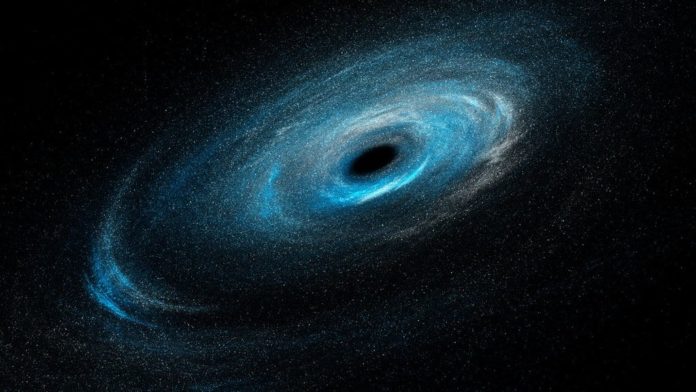The mysterious aspect of black holes (as if they weren’t peculiar enough) is that the magnitude of their mass exists on either end of the spectrum but doesn’t span across it. Now that’s a bit odd, isn’t it? As the laws of the universe have it, the nature of mortal or inanimate objects is to have characteristics (from standard variables like size and temperature to more sentient factors like emotional tendencies) that span across a rough range from low to high. Black holes, however, living up to their enigmatic facade either exist as supermassive black holes or really tiny ones.
Till now, black holes have been fundamentally divided into two types. There are stellar black holes, which form when a giant star collapses in on itself, compressing the mass of five or more of our suns into an infinitely small point. They just float around the universe, ruthlessly engulfing anything that gets in their way. Then come the giants. And when we say giants, we are talking about black holes with their mass as high as millions or even billions of our suns; so it’s safe to say that they define the term gargantuan!

Karen Uhlenbeck wins Abel Prize, thereby becoming the first woman to do so
A universe’s inception could be linked to its parent supermassive black hole as theorized by astronomers Donald Lynden-Bell and Martin Rees in 1971. Their hypothesis proposed the idea of blank spaces at the center of every galaxy potentially containing these impenetrable giants. This theory took form when astronomers proved the existence of a black hole named Sagittarius A*(an awfully cheerful name for an engulfing giant) at the center of our own galaxy, the Milky Way.
With time, scientists and astronomers proposed various theories and conclusions about the perplexing relationship between a galaxy and a black hole. It was observed that a bigger black hole held with it, a bigger galaxy having a faster spin. So that suggested that the black holes might actually play a role in how galaxies are formed — but if they were there before the galaxy was, then where did they come from?

But hey, we mentioned another type of black hole previously. Perhaps that could shed some light on the genesis of this mind rattling phenomena. Sadly, these black holes stay away from potential answers. These things are way tinier than their supermassive counterparts, like billions of times tinier, making it very unlikely that stellar black holes have anything to do with the creation of supermassive black holes. Yet again, we find ourselves at a dead end. But you didn’t come here to know that this enigmatic giant tricked you again into believing you had it figured out? Fortunately for us, a missing link has opened the doors to further analysis of this mystical phenomena.
In 2016, observers at Japan’s Keio University noticed something that just might link the two types of black holes. A gas cloud near the center of the galaxy (but not inside it) was found to be accelerating in a strange way that suggested it was being influenced by a giant black hole. But not too giant — they’re calling this one an “intermediate-mass black hole”. If it really is a black hole like they think it is, it’s still about a million times smaller than Sagittarius A*.
This piece of information could finally uncover the bizarre veil clouding the nature of a supermassive black hole and reveal the truth (or at least a part of it). From what we have discovered, Supermassives could either form by slowly sucking up errant gas until they get big enough to either form the core of a new galaxy or crash into the central supermassive black hole of the galaxy they’re currently in.
Before we dive in further, lets reel back a little and understand a few fundamental aspects of a black hole. Throughout this discussion, we have been comparing black holes with terms like “supermassive” or “tiny”. While these refer to sizes of objects on face value, what do they mean in black hole terms? Do black holes vary in size dimensionally? Intriguingly, they don’t and it is quite simple why. That’s because a black hole is just any non-zero amount of matter condensed into a one-dimensional point — and more matter means high density.

If we are really interested in sizes here, it could be determined by the event horizon of a black hole. That refers to the radius surrounding the black hole at which you would have to be moving at the speed of light in order to escape its gravitational pull. The denser the hole, the larger the event horizon. The radius encapsulating the event horizon of a black hole is called a Schwarzchild radius, and to the naked
Since we have thrown a lot of fancy terms around, it’s now time to draw some interesting analogies to lighten the expanse of information you have just assimilated. If the sun were to collapse into a black hole tomorrow, then its event horizon would be about 2.95 kilometres (about 1.83 miles) from its centre. The smallest black hole we know about has the mass of 3.8 suns, making its Schwarzchild radius about 11 kilometres (7 miles). Even the largest stellar black hole would only have an event horizon extending out 46 kilometres (28 miles). Sounds nice enough. Just to end things, we want to throw in there that the Sagittarius A* has an event horizon extending to about 13.3 million kilometres (8.26 million miles) in every direction. And with that terrifying turn, we leave you to your thoughts.
Further Reading:



“Sagittarius A* has an event horizon extending to about 13.3 million kilometres (8.26 million miles) in every direction. ” I’m trying to speculate!
wondernspeculate.wordpress.com